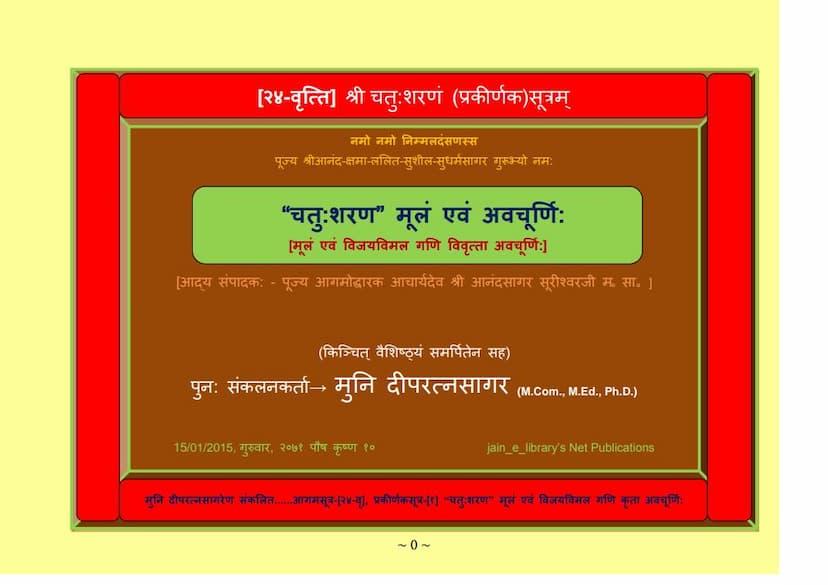Aagam 24 V CHATU SHARAN Moolam Evam Vrutti
Added to library: September 1, 2025

Summary
This document is a detailed Jain scripture titled "Aagam 24 V CHATU SHARAN Moolam evam Vrutti", authored by Dipratnasagar and Deepratnasagar, and published by Deepratnasagar. It is a Net Publication by jain_e_library.org.
The text is a reproduction of the "Chatuhsharana Prakirnaka Sutra" (Sutra No. 1 of Prakirnakas, and 24th in the Agam sequence). It includes the original sutra (Moolam) and a commentary (Vrutti or Avachurni) by Vijayvimal Gani. The work has been further compiled and edited by Muni Deepratnasagar, with initial editing and revision by Acharya Shri Anand Sagar Surishwarji (also known as Sagaranand Suriji).
The publication's aim is to make ancient Jain scriptures accessible in a modern, digital format, ensuring clarity for the reader by presenting the original text alongside the commentary. The editor, Muni Deepratnasagar, expresses his dedication to serving the Agamas and his gratitude for the opportunity to republish this work. He highlights the special formatting with section titles, verse numbers, and a detailed index ("Deep Anukram") to aid study. The publication also includes footnotes for clarification and to address any printing or numbering errors in the original source.
The core of the scripture, the "Chatuhsharana Prakirnaka Sutra," is a profound discourse on taking refuge in the "Four Sharanas". The text systematically explains these four refuges:
- Arhanta: The liberated souls who have conquered all internal enemies like attachment, aversion, and delusion. The text elaborates on the various qualities of the Arhats, emphasizing their role in guiding souls towards liberation.
- Siddha: The perfected souls who have attained omniscience and eternal bliss, free from all karmic bondage. The text details the characteristics of Siddhas and their exalted state.
- Sadhu: The virtuous ascetics who follow the path of righteousness and practice the teachings of the Tirthankaras. The scripture enumerates various types of Sadhus and their exemplary conduct.
- Dharma: The true path of liberation, as expounded by the omniscient Tirthankaras, encompassing right faith, right knowledge, and right conduct. The text highlights the efficacy of Dharma in overcoming suffering and achieving spiritual bliss.
The scripture then delves into the practice of seeking refuge in these four, describing the devotional attitude and emotional state required for such surrender. It emphasizes the importance of:
- Dushkrit Garha (Repentance of Misdeeds): The text details the process of confessing and regretting wrongdoings, a crucial step in spiritual purification.
- Sukritaanumodana (Appreciation of Good Deeds): It encourages the admiration and approval of virtuous actions performed by oneself and others, fostering a positive spiritual disposition.
The commentary explains the meaning and significance of each verse, often providing multiple interpretations and connecting them to broader Jain philosophy. The text also includes descriptions of the auspicious dreams that foreshadow the birth of Tirthankaras, further emphasizing the divine nature of the Dharma.
The latter part of the scripture discusses the fruits of following the "Chatuhsharana", such as the transformation of karma from negative to positive, leading to spiritual advancement and eventual liberation. It also includes a lamentation for those who, despite having the rare opportunity of human birth, fail to practice these principles, highlighting the preciousness of this human existence.
Finally, the scripture concludes with the importance of meditating on this knowledge and its role in overcoming the great enemy of negligence (pramada). The text is attributed to Muni Virabhadra, a disciple of Lord Mahavir, and the commentary by Vijayvimal Gani further illuminates its profound spiritual message. The overall purpose of this publication is to disseminate this valuable Jain scripture for the spiritual benefit of all.